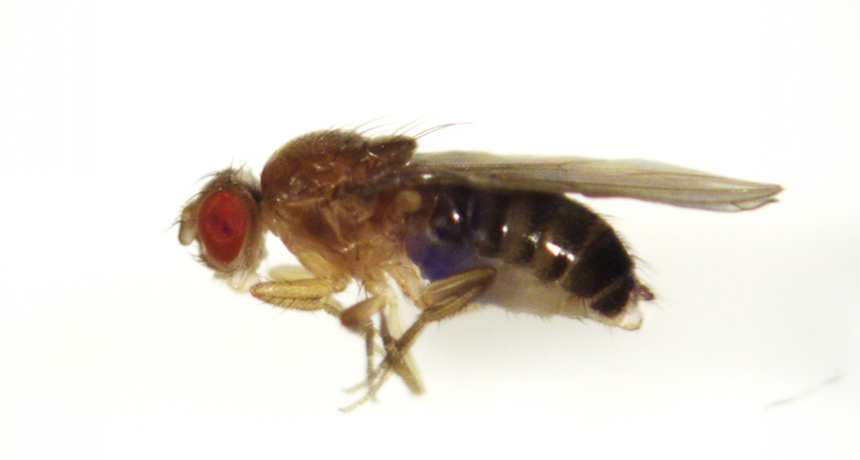A science fair project makes bug killing sweet
Simon Kaschock-Marenda found a new, safer-to-use insecticide by testing sweeteners on flies

This fruit fly has a blue belly, proof that it ate blue-dyed erythritol. The sweetener is harmless to people, but deadly to fruit flies.
Kaitlin Baudier/Drexel University
Sometimes finding a science fair project is as simple as looking around the breakfast table. That’s what sixth-grader Simon Kaschock-Marenda did. He noticed what members of his family had been using to sweeten their drinks. “My grandmother, my mom and my dad were all using different sweeteners,” recalls Simon, now 14 and a rising sophmore at the Julia R. Masterman Laboratory and Demonstration School in Philadelphia. “I decided to test to make sure all the options were healthy.”
His guinea pigs: fruit flies. These are the little bugs that buzz around overripe fruit. They also are a common animal used to study biological processes. But when Simon added different sweeteners to fruit fly food, his stumbled upon a real surprise. One sweetener poisoned the insects. Simon’s father, Daniel Marenda, is a neuroscientist at Drexel University in Philadelphia. He took his son’s results a few steps further. Now, both father and son are among the authors of a new paper in PLOS ONE. It shows that one of the main components in Truvia — a very low-calorie sweetener made from the sweet leaves of the Stevia plant — kills fruit flies. The results could lead to an insecticide that is safe for use around people.
The experiment started out simply enough. “We went out to the supermarket and we bought every sweetener that we could find,” Daniel Marenda explains. “I gave Simon some fruit flies and helped him mix the sweeteners with the fly food.” The father-son team mixed normal fly food with sugar or with a brand name low-calorie sweetener such as Truvia, Equal, Splenda, Sweet N’Low or PureVia. Simon put the flies and their food in his closet and checked them every day, counting any that had died.
Simon’s dad didn’t expect this project would find anything useful. He assumed all the flies would die at the same rate. He was wrong. “After about six days, Simon came up to me and said all the flies in the Truvia vial were dead,” Marenda says. Father and son decided to take the project further. They repeated their tests with more flies and different concentrations of sweeteners. When the Truvia flies kept dying, Marenda talked to an entomologist and took the project to his laboratory at Drexel.
After three years and many more experiments, Simon’s findings have still held up. Truvia kills fruit flies. The culprit is erythritol. It’s an alcohol prepared from a sugar that remains very low in calories. It has a sweet flavor and makes up 95 percent of Truvia. Although flies love the sweet chemical, erythritol doesn’t love them back. It quickly stops the bugs from moving normally. Within a few days, all are dead.
But while it’s deadly to flies, erythritol poses little risk to people. “Many of the pesticides in use now and in the past have hurt the people working with the crops,” Simon says. Since erythritol doesn’t hurt people, the teen hopes it could serve as the basis of a newer, safer bug killer.
The project taught Simon about more than sweeteners. “I learned how difficult it is to really control an experiment,” says Simon. “You can’t jump to conclusions because you have exciting results.” His dad learned important lessons as well. “I never would have studied sweeteners if Simon hadn’t wanted to look at them for a science fair project,” he says. “I learned to always follow up on my son’s inquisitiveness!”
The neuroscientist and his colleagues currently are conducting tests to see if erythritol kills other bugs in addition to fruit flies. If it does, the researchers will start work on a safe erythritol insecticide. From sweetener to bug killer, a science fair project has come a long way.
Follow Eureka! Lab on Twitter
Power Words
entomology The scientific study of insects. One who does this is an entomologist.
erythritol A chemical approved as a food addictive. It has a sugary flavor but almost no calories. That’s why food manufacturers use it to help give bulk to branded sweeteners such as Truvia. Normal doses of erythritol are harmless to most people. High doses can cause nausea and upset the stomach.
fruit flies Tiny flies belonging to the species Drosophila melanogaster. Scientists often use these short-lived animals as a “guinea pig” for lab studies because they are easy to grow, can mature into adults in a short time and their bodies share many of the same traits and responses as more complex animals — including mammals.
insecticide A substance used to kill insects.
neuroscience Science that deals with the structure or function of the brain and other parts of the nervous system. Researchers in this field are known as neuroscientists.







